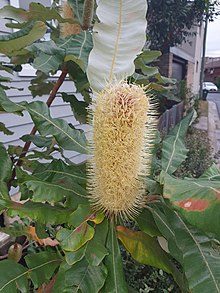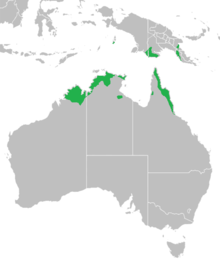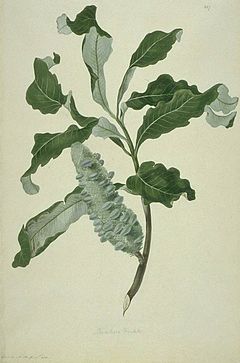| Banksia dentata | |
|---|---|

| |
| Scientific classification | |
| Kingdom: | Plantae |
| Clade: | Tracheophytes |
| Clade: | Angiosperms |
| Clade: | Eudicots |
| Order: | Proteales |
| Family: | Proteaceae |
| Genus: | Banksia |
| Species: | B. dentata
|
| Binomial name | |
| Banksia dentata | |

| |
| Range across northern Australia, southern New Guinea and Aru Islands (Trangan) | |
| Synonyms[2] | |
| |

Banksia dentata, commonly known as the tropical banksia,[3] is a species of tree in the family Proteaceae. It occurs across northern Australia, southern New Guinea and the Aru Islands. Growing as a gnarled tree to 7 m (23 ft) high, it has large green leaves up to 22 cm (8.7 in) long with dentate margins. The cylindrical yellow inflorescences, up to 13 cm (5.1 in) high, appear between November and May, attracting various species of honeyeaters, sunbirds, the sugar glider and a variety of insects. Flowers fall off the ageing spikes, which swell and develop follicles containing up to two viable seeds each.
Banksia dentata is one of four Banksia species collected by Sir Joseph Banks in 1770, and one of the four species published in 1782 as part of Carolus Linnaeus the Younger's original description of Banksia. Within the genus, it is classified in the series Salicinae, a group of species from Australia's eastern states. Genetic studies show it is a basal member within the group. Banksia dentata is found in tropical grassland known as savanna, and associated with Pandanus and Melaleuca. It regenerates from bushfire by regrowing from its woody base, known as a lignotuber.
- ^ George, A., Keighery, G. & Atkins, K. 2020. Banksia dentata. The IUCN Red List of Threatened Species 2020: e.T112521627A113306531. https://dx.doi.org/10.2305/IUCN.UK.2020-2.RLTS.T112521627A113306531.en. Accessed on 01 September 2023.
- ^ a b "Banksia dentata". Australian Plant Census. Retrieved 22 April 2020.
- ^ "Banksia dentata R.Br". FloraBase. Western Australian Government Department of Biodiversity, Conservation and Attractions.
